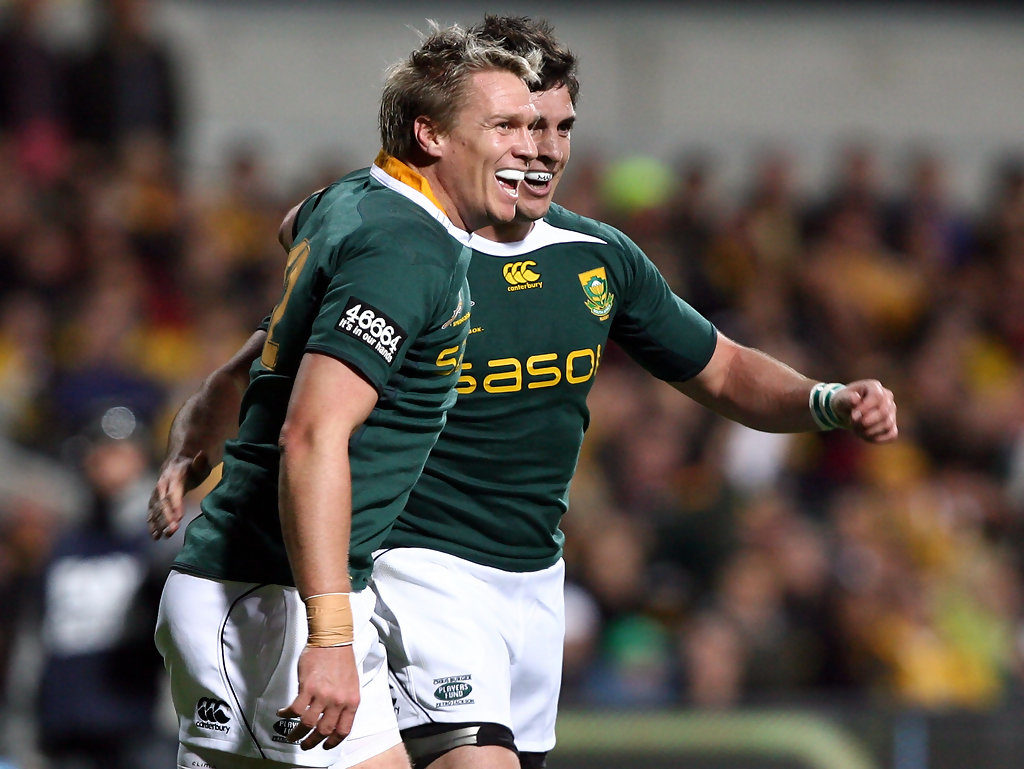In the second instalment of a five-part series, SA Rugby magazine’s writers pick their best Springbok XV of the past 25 years.
OUR SPRINGBOK XV: The back three
JON CARDINELLI: Jaque Fourie seemed to get better with age. Indeed, one wonders how much more he may have achieved had he remained with the Boks – rather than his club in Japan – during the latter stages of his career.
Jesse Kriel and Lukhanyo Am have given Bok fans reason to cheer in recent years, with the latter’s vision and organisational ability playing a key role in the 2019 World Cup triumph. In time, Am may go on to surpass Fourie as the greatest No 13 of the professional era.
It was a joy to witness Jean de Villiers and Fourie operating in tandem. The two versatile players complemented each other well on attack and defence. With regard to the latter discipline, the pair had few rivals during the professional era.
De Villiers – who was central to South Africa’s success in the series against the British & Irish Lions and subsequently the Tri-Nations victory in 2009 – went on to lead the Boks between 2012 and 2015. He won his 100th Test cap in 2014.
CRAIG LEWIS: This doesn’t need much debating, does it?
I loved De Wet Barry and Marius Joubert in their prime, and the duo brought the best out of each other. A left-field selection temptation could also be to install Frans Steyn as the inside centre choice, but it’s just unfortunate that he was never able to play more in his best position for the Boks.
So, ultimately, you can’t look further than Messrs De Villiers and Fourie, who are far and away the most-capped centre combination for the Springboks, having manned the midfield together in 29 Tests.
You’d take these two any day of the week!
FROM THE VAULT: 20 best Boks (1995-2015)
WADE PRETORIUS: Two names and then we rest the case, right? It would be absurd to look beyond the pair of Jean de Villiers and Jaque Fourie (lockdown has me screaming JAQUE fourie in my best Hugh Bladen impersonation). We all agree the Damien de Allende and Lukhanyo Am partnership looks to be extremely promising but the former has no chance of eclipsing the career of Jean de Villiers leaving only the latter the uphill, albeit not insurmountable, climb to try match the feats of Fourie.
Both De Villiers and Fourie suffered numerous setbacks but their ability to bounce back defied logic. Their combination was one created in a rugby laboratory – the 12 with excellent hands and vision, the 13 a dynamic runner and fierce defender. That said, De Villiers was never criticised for abandoning his defensive duties and both were quick as they come. Intercepts, gainline breaks, the simple made easy … there was nothing this pair couldn’t do.
MARIETTE ADAMS: I know selection is a matter of personal opinion, but really this one should be unanimous.
The Jean de Villiers–Jaque Fourie centre combination was for Bok rugby what Conrad Smith and Ma’a Nonu gave All Blacks rugby. Invaluable, irreplaceable, indispensable. Take your pick.
De Villiers earned 109 Test caps between 2002 and 2015 and 27 tries, while Fourie made 72 Test appearances between 2003 and 2014 and scored 32 tries.
Despite his sudden and somewhat premature retirement from international rugby in 2014, his greatness in the green and gold was unquestionable. Mossie, as he was known, is arguably the greatest outside centre this country has ever produced and he would have potentially achieved even more, had he continued his Bok career.
On his part, De Villiers went on to become one of the great Springbok leaders of our time despite having to manage a body – and ultimately piloting a career – ravaged by injuries.
Yet despite all that, watching the king of the intercept and the minister of defence in unison in the Bok (and Stormers) midfield, was pure bliss.
DYLAN JACK: There can only really be one midfield combination that fits the bill here. Jean de Villiers and Jaque Fourie took the Springboks through one of their most successful periods initially under Jake White and then under Peter de Villiers.
It was a shame that their partnership was disrupted by Fourie’s departure to Japan as one is left wondering how much the two would have achieved had he stayed in South Africa. It is also a pity that De Villiers’ Test career ended as it did in 2015. In truth, he never seemed to have fully recovered from the horrific knee injury he suffered in Cardiff the year before.
Nevertheless, De Villiers and Fourie will always be regarded as one of the finest combinations in Test rugby history. De Villiers brought the subtlety, while Fourie was simply a force of nature on both attack and defence.
Photo: Gallo Images





